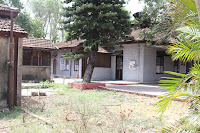The president's house at Spicer tells a story even without words. The large portico with trellis for walls, built around an old tree, suggests a desire to relax in the open but with protection. The spacious rooms with tall windows and carved-wood framing enormous mirrors speak nobility. What is now the dining room once opened to the sky. Fish lazed in a little indoor pool here. (So said the son of Pastor Pohlman, the first president to live in the house)
Despite having many rooms the mansion contained no kitchen.
The narrow passageway that is now the kitchen simply led out the back door --to the next building housing the bakery. There the servants prepared food for the stately guests of the mansion. This building has only slightly been altered to accomodate at various times a sports storage, security office, post office, and STD, PCO, besides the perennial bakery.
A stone's throw away, across what is now called the "Taj Mahal Road" stands a long but small old building (for years our dispensary), appropriate for a raja's servants. The college store opens with large doors at literally ground-level to accommodate, we have been told, the entrance and exit of horses. There may have been more structures because we are told that these are all that remain of the original buildings.
The above description for the photo of the house in the 1990 Oreodoxa with the statement that the place had served as a palace of the Raja of Aundh was provided by Dr M E Cherian who not only served as college president from 1963-1990, but who studied at the college before that from 1945-1949, just a few years after the estate was purchased in 1941.
But this view was challenged recently in an online discussion on the heritage of the Spicer Campus. The state of Aundh and its famous Raja were actually way in the south of Maharashtra near Satara whereas Pune and the nearby village of Aundh are in North. The Raja of Aundh near Satara was the one who experimented with Panchayat Raj as propounded by Mahatma Gandhi and the concept of the open prison as depicted in the movie "Do Aankhen Barah Haath." (See Wikipedia)


The State of Aundh according to the Imperial gazetteer (see Wikipedia) and His Highness Meherban Shrimant Raja Bhavan Rao Shrinivas Sahib, the Pant Pratinidhi of Aundh (1868-1951)
So I asked Mr Gompa Devadas our secretary of the India Financial Association to check the property deeds of Spicer. He pored over a ream of papers in the file and brought this document to me. This is what it contains:
"AND WHEREAS by reason of a partition, between the descendants of the original grantee, the village of Aundh, taluka Haveli, District Poona, has been put to the share of the family of Shri Vighneshwar Bin Narayan Maharaja,
AND WHEREAS the Lessors are the full owners as Inamdars of the said village of Aundh, including the full and absolute rights over the trees and forests, the rivers, brooks and Nallas, etc.,
AND WHEREAS the LESSEES are in possession of the Lands of Survey nos . . . ."
The document informs us that we purchased the property from a certain party but that this property had at one time belonged to a Maharaja of Aundh.
So our village of Aundh had a Maharaja not to be confused with the Pant Prathidhini of the Sate of Aundh.
Here are some pictures of the residence as it stands today (per kindness of Maple Christina, secretary of the president/Vice Chancellor)
 |
| The portico originally had wooden trellis sides and a tiled roof. |
 |
| A tree stood in the center here and grew out of the roof |
 |
| Front and right side. |
I am unable to find more details of Maharaja Vighneshwar Bin Narayan. An internet search throws up a current saint by a similar name. If anyone has the opportunity to pursue this search into government archives please let me know what you find.



